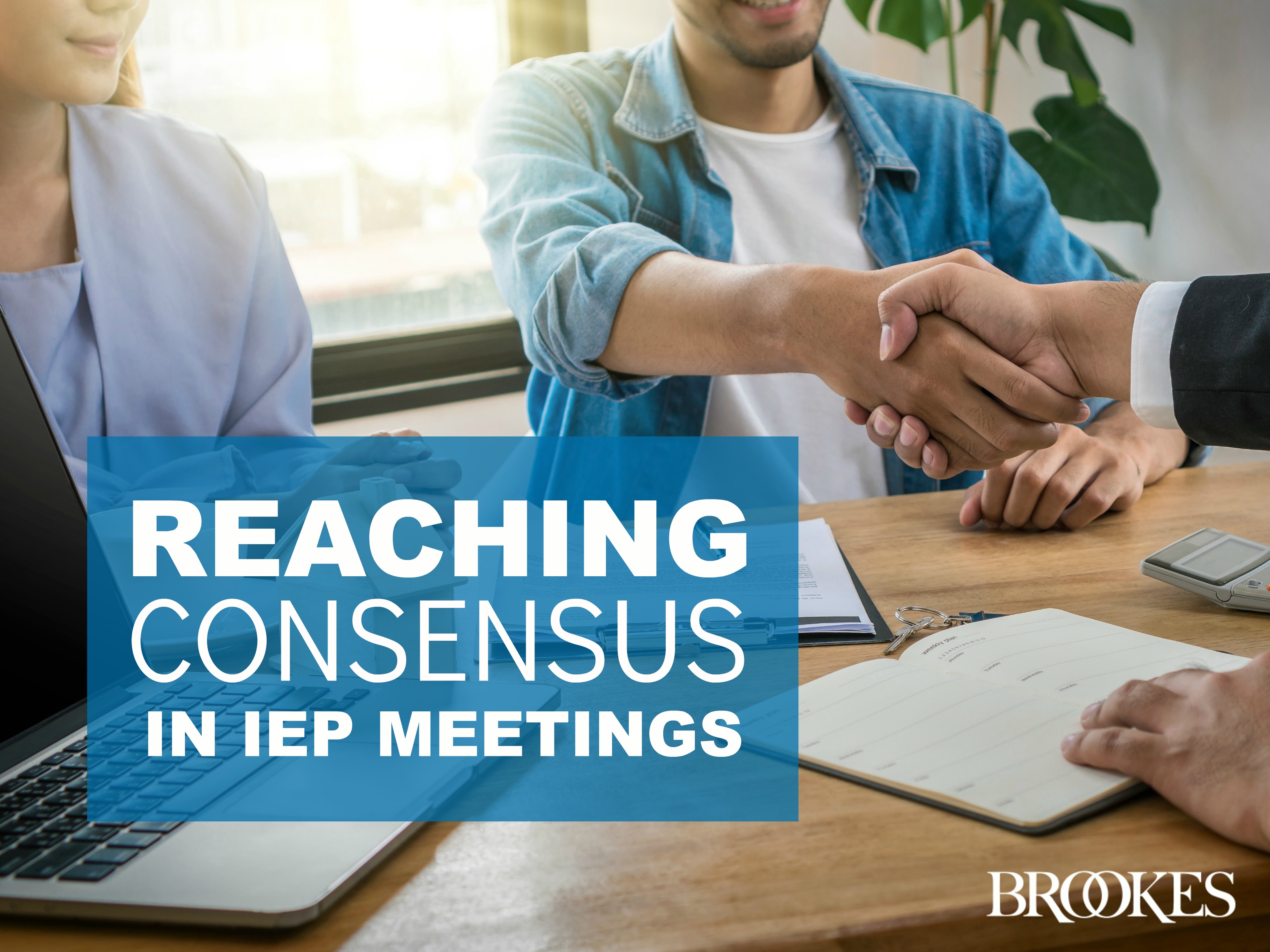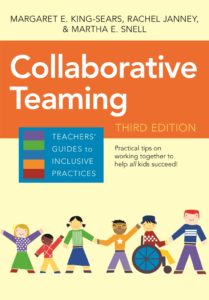5 Steps to Reaching Consensus in IEP Meetings
March 3, 2020
Into almost every IEP meeting, at least a little conflict must come. With so much at stake for the student—and with so many different people trying to reach consensus—it’s easy to see why. Today’s post offers some helpful guidance on how to work through conflict in these meetings and reconcile the diverse perspectives of parents, teachers, and other team members.
During IEP meetings, beliefs and values shape each person’s position. Differing beliefs and values are informed by lots of factors: culture, background, upbringing, language, religion, and education. Families and school personnel may arrive at an IEP meeting with completely different approaches to key issues, such as the meaning of disability, the roles of parents and children, and the goals they feel are appropriate for the student to work toward.
 So how can IEP teams resolve the differences between two distinct viewpoints? In the book Collaborative Teaming, the authors describe a five-step approach* teams can use to bridge that gap. From identifying the issues to collaborating based on shared values, this process can be used to help your team defuse conflict, recognize common ground, and work together effectively for the benefit of the student. The vignettes below, excerpted and adapted from the book, help illustrate each of the five steps.
So how can IEP teams resolve the differences between two distinct viewpoints? In the book Collaborative Teaming, the authors describe a five-step approach* teams can use to bridge that gap. From identifying the issues to collaborating based on shared values, this process can be used to help your team defuse conflict, recognize common ground, and work together effectively for the benefit of the student. The vignettes below, excerpted and adapted from the book, help illustrate each of the five steps.
Step 1
Identify the issues: What are the major points of disagreement between IEP team members?
Everyone left the last IEP meeting for Darrell feeling discouraged. His transition plan was not completed because the team had reached a stalemate on the issue of transportation to potential workplaces. Darrell’s parents didn’t want him to learn how to use the bus system to travel to worksites, but the school personnel felt that using public transportation was a valuable component of career readiness for him. The school-based team members didn’t understand why Darrell’s parents were so resistant to something that promoted their son’s independence and would help him access employment.
Step 2
Identify the professionals’ underlying values: What beliefs and feelings are contributing to the school team’s viewpoint?
The school personnel placed a strong value on independence for Darrell. They felt that if Darrell could travel independently, then his reliance on family members or others for transportation wouldn’t be an issue that could limit his career choices in the future.
Step 3
Identify the parents’ underlying values: What beliefs and feelings are contributing to the family members’ viewpoint?
Darrell’s parents placed a strong value on safety for their son. Although Darrell’s parents understood that the school team meant well for Darrell and also wanted him to be safe, his mother still feared for his safety on the bus. Darrell’s parents also regularly relied on extended family members being able to drive Darrell to worksites. Providing their own transportation was a source of pride for this family; they did not need to ride on the bus.
Step 4
Discuss beliefs: How can all parties understand each other’s perspectives better?
Later that week, the special educator walked with Darrell to his mother’s car when she came to pick him up after school. The special educator asked his mother, “Can you tell me why preparing Darrell to ride the bus is something you don’t want? If we taught him how to get different places on the bus, then he could also get to the movie theater, the mall, and other places for some free time on his own.”
Darrell’s mother responded with stories she had read about teenagers getting into trouble on the bus. She shared her concerns for his safety. Then she looked at the car she was driving and told the special educator, “We worked very hard to get this car. My sister and her family also have a car. So does my brother-in-law, who lives near us. We help each other all the time for driving.” She continued, “I want Darrell to find good jobs. I appreciate what you and others are doing to prepare him for careers after graduating from high school. But I do not want to worry about his safety on the bus.”
Through this open conversation, the special educator now fully realized why Darrell’s mother was so resistant to the bus transportation. She understood the safety concern on a deeper level, as well as the pride that Darrell’s family took in providing their own transportation.
Step 5
Collaborate by focusing on values shared with the parent: How can both sides find common ground and work together toward their shared goal?
The special educator continued the conversation with Darrell’s mom. The teacher started out by acknowledging what they both wanted for him: “I understand what you’re saying. We both want Darrell prepared for a career with a good salary that also has benefits.” Then the teacher presented a solution that would directly address the safety concerns Darrell’s family had brought up: “We didn’t mention this at the last team meeting, but Darrell is not riding the bus alone. An adult from school would always be with him and some of his peers who are also learning how to use the bus. I’ve read about the safety issues on the bus, too. Those incidents happened in the evening and in other parts of town. But we wouldn’t be on the bus at that time or in those places. Would you be okay if an adult and some other students were on the bus with Darrell?”
Darrell’s mother felt reassured by this interaction, and by the school team’s willingness to address her concerns with concrete solutions. Since having bus transportation would open up new possibilities and opportunities for Darrell, his family agreed that he could learn to ride the bus under those conditions.
***
As the authors of Collaborative Teaming state, “Effective collaborative teams are not about any one team member getting what he or she wants; effective collaborative teams are about each team member contributing in ways that enable students to get what they need.” Use the example in this post as inspiration for defusing conflict in your own IEP meetings—and for more guidance on collaboration in inclusive education…
EXPLORE THE BOOK
 Collaborative Teaming, Third Edition
Collaborative Teaming, Third Edition
By Margaret E. King-Sears, Ph.D., Rachel Janney, Ph.D., & Martha E. Snell, Ph.D.
Packed with practical tips, tools, and vignettes, this guidebook shows your staff how to work together effectively to support students with disabilities in inclusive classrooms.
LEARN MORE NOW
*The five-step model in this post was originally described in the research of Kalyanpur, M., & Harry, B. (2012). Cultural reciprocity in special education: Building family–professional relationships. Baltimore, MD: Paul H. Brookes Publishing Co.




Write a Comment
Your email address will not be published. Required fields are marked *
Post a Comment